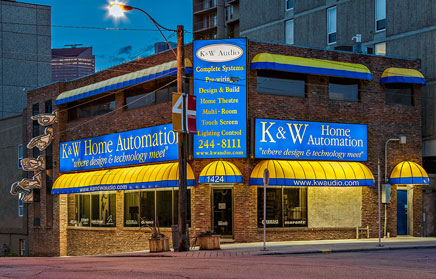TIP #26:
Whether listening to a fine sonata on your stereo system, or feeling the crunch of the Terminator’s foot on your subwoofer assisted home theatre system, our seating situation can have a dramatic effect on our perception of the audio experience.
Although there is no magic formula or rule of thumb which can provide us with perfect reproduction, the implementation of some general set-up rules, and a little time and experimentation, can bring us closer to that perfection.
First, the relationship between the listener and the main loudspeakers must be addressed. Begin by determining the “comfy spot”. This technical process requires a certain amount of time and experimentation, testing the tush factor in all appropriate locales in the room where your system resides. Interestingly, the comfy or “sweet spot” is easy to remember, as all bodies in the room seem to be attracted to this point every time. Even if you have a large house on a large lot, when the evening’s relax time arrives, this spot will be occupied by the entire family, and any pets can quietly slide their way into the room as well.
Once the “sweet” or “comfy spot” has been established, we can turn our attention to placement of the main channel speakers. It makes no difference if you have a surround or a two channel system, this step is common. Ideally, the main speakers and the sweet spot should become the three corners of an equilateral triangle.
For accurate bass response with floor standing speakers, place them at a distance from the wall(s) measuring at least the greater of the width or depth of your speaker. They should fire squarely into the room, with no toe in to the listener. If possible, the distance of the speakers from the adjacent walls should be the same. Use Scotch tape on the floor to mark this position.
Now select a piece of music, preferably with a single singer and musical accompaniment, and sit in the sweet spot. If you have a surround system, be sure that all other speakers are off. At this point we are listening to main speakers only. Sounds great? Hey! Get back to work. You are now going to listen for something called “centre fill”. This is when you can experience the sensation of sound coming at you from between the loudspeakers, not the speaker enclosures themselves. As you listen, the vocalist should be entertaining you from this central point.
Should you notice that the vocalist is diffused, or stretched, across the room, and definitely not in the centre, get up (this is work now), and toe each speaker in towards the listening position a very small amount. Employing a dedicated speaker turner can help reduce the strain here. Listen and adjust, listen and adjust, you will notice that the voice becomes progressively tighter and easier to pinpoint as coming from the midway between the speakers.
If you toe in the speakers too far, the instruments will lose their authority and become thin, and the soundstage will become “beamy”, which means that a small movement in the sweet spot will change the voice position. In this case start moving the speakers out again, and rejoice!…. you are now close to optimum.
When the vocalist is singing with authority at centre stage, and there are no “holes” in the image, and small twitches while listening do not affect the image, you are done. Often, optimum is where the listener can no longer see the sides of the speaker cabinets. This is a function of the individual speakers, and the reason why we are optimizing. Noticing how much of each cabinet’s side can be seen from the listening spot is the best way to ensure that you have the same amount of toe in on both loudspeakers.
OK, if you have only two speakers you are done, you are excused to relax, listen and enjoy. However, if you have a surround system, we have a few more things to do. Let’s turn our attention to the centre speaker. This speaker is included in a Pro-logic system to reproduce the sound of the speaker situated directly behind the screen in a theatre environment. The purpose of this speaker is to anchor sounds to the picture. Often this is conversation, but can include exploding cars, uzis and things that go goosh, all of which should appear to emanate from the screen.
This makes the centre channel speaker critical in creating a sense of reality, and should draw you into the experience. The centre channel is only used in movie processes (Pro-logic, Pro-logic 35mm Enhanced, 70mm, THX etc.). Even if the TV screen is not directly between the two main loudspeakers (the ideal situation), the centre channel should be placed on top of, or beneath the screen, rather than at the centre point between the two main loudspeakers. Hopefully, these two points are the same.
Rear channel speakers are also very important in home theatre applications, but they are crucial in DSP. DSP is the reproduction of a specific environment (concert hall, jazz club, church, stadium, etc.) and, since no screen is required the centre channel is not used. The rear speakers now take on the all important job of reproducing the reverberations and ambiance of these different settings. Since these speakers are creating ambiance, anything we can do to assist will reap an acoustical benefit.
Currently, bipolar loudspeakers (speakers that radiate both front and back) are the best at creating the proper defuse and realistic sense of ambiance. They are placed behind the listener, high enough, or far enough back so that each speaker can interact and “talk” to it’s buddy, before the sound reaches the listener. The “rears” create ambiance and the sense of sounds emanating from places other than where the speakers are situated.
After you have placed your speakers properly in your home theatre system, don’t forget the most important last step. Calibrate the system using the pink noise generator built into your unit. That’s the button that causes that annoying hissing sound. Sit in the comfy spot with your remote control (no pain, no gain) and push “test”. Listen and compare sequentially, the volume of hiss that emanates from each of the speakers.
Set the volume on the centre and rear channels to match the mains. This tells the processor where you are sitting, where the speakers are located, the size of the room and a bunch of other useful stuff needed to make sure that your room sounds just like the environment you can now select with just the push of a button.
After all that work you probably need a rest, so try some music or watch a movie…… and don’t let the cat boss you out of your rightful place on the sweet spot!


